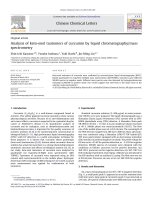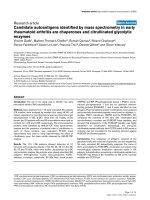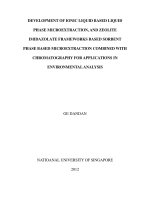Investigation and application of liquid chromatography mass spectrometry in the analysis of polar, less volatile and thermal unstable organic pollutants in environmental and biological samples 4
Bạn đang xem bản rút gọn của tài liệu. Xem và tải ngay bản đầy đủ của tài liệu tại đây (577.48 KB, 47 trang )
4. Chapter Four
Microwave-assisted Extraction of Pesticides
4.1 MICROWAVE-ASSISTED EXTRACTION BEHAVIOR OF NON-POLAR
AND POLAR POLLUTANTS IN SOIL WITH ANALYSIS BY HPLC
4.1.1 Introduction
As mentioned in the previous chapter, carbamate pesticides are gaining importance in the
field of pest control because of their high efficiency as insecticides and nematicides, and
their low bioaccumulation potentials. However, since they are acetylcholinesterase
inhibitors, they are considered hazardous to the environment and to human health [1-3].
Evaluation and monitoring of trace levels of these compounds in soil are important
because the widespread use of carbamates in agriculture leads to an increase in the
presence of their residues in environmental matrices, especially soil.
HPLC has been applied routinely in the analysis of carbamates due to their suitability for
thermally labile and polar pesticides. To obtain the cleanest samples and to avoid
pesticide degradation during the extraction from soils, an adequate sample preparation
technique with optimum extraction conditions is crucial prior to the final determination.
As we discussed before, MAE has become a very attractive sample preparation technique
for solid samples because of its enhanced extraction times, low solvent consumption and
improved extraction efficiencies. It can be used to extract not only non-polar analytes
73
from solid matrices but also polar and ionic compounds [4]. Moreover, simultaneous
extraction of multiple samples is possible. In the past few years, MAE has been
successfully applied to the simultaneous extraction of toxic organic contaminants from
different solid matrices, such as PAHs [5-14], PCBs [15-18], organochlorine pesticides
[19-21], phenols [22-24], herbicides [25-27], triazines [28-31] and organomercury
compounds [32-36]. But hitherto, little work has been reported on the MAE of
carbamates [37].
In this work, MAE was applied for the first time to study carbamates. Our focus is firstly
on the thermal instability of carbamates in different extraction solvents under MAE
conditions, our second focus is to compare the MAE efficiency for relatively more polar
organic pollutants, such as the carbamates themselves (propoxur, methiocarb, propham,
thiuram, chlopropham) and triazines (atrazine, simazine) with that of relatively non-polar
substrates, such as PCBs (PCB1242, PCB1248) and PAHs (naphthalene, phenanthrene).
Furthermore, we also pay particular attention to the optimization of the parameters that
influence MAE efficiency, including the polarities of the solvents, extraction
temperature, extraction pressure and heating duration.
74
4.1.2 Experimental
4.1.2.1 Reagents and soil preparation
Analytical-grade PAHs (naphthalene and phenanthrene), PCB (PCB-1242 and PCB-
1248), triazine (atrazine 98% and simazine 99%), and carbamates (propoxur 99%,
methiocarb 99%, propham 99.5%, thiuram 98%, chlorpropham 99.5%) were used in this
study (See Chapter 2).
Three soil samples were collected from local sites (soil-1, soil-2 and soil-3, respectively).
The preparation of blank soils, freshly spiked soils and aged spiked soils were described
in Chapter 2.
4.1.2.2 MAE procedure and treatment of extracts
In this study, 30 ml extractant was added to the MAE extraction vessel, which contained
2.0 g of spiked soil sample. Extraction was performed at 115°C with a heating time of 6
min for PAHs and PCBs, or 4 min for triazines at 80% power. After the extraction, the
vessels were cooled down to room temperature before they were opened. Sample extracts
were further clarified by centrifugation at 419 rad/s for 15 min to separate out the fine
particulate. The supernatant was then evaporated to dryness in a rotary evaporator.
75
Finally, 1 ml of methanol was added to dissolve the residue. 10 µl of the solution was
directly analyzed by HPLC.
In order to examine the thermal degradation behavior of carbamates, the following was
performed: 2 ml of standard solution containing 2 ppm of propoxur, thiuram, propham,
methiocarb and chlorpropham was evaporated to dryness and, then 30 ml of the
appropriate extractant was added to dissolve the residue. The solution was transferred to
the extraction vessel (no soil inside) and MAE was performed at 95 °C for 6 min at 80%
power. After the extraction, the vessel was allowed to cool down to room temperature
before it was opened.
4.1.2.3 HPLC measurements
For triazines: A Phenomenex (Torrance, CA, USA) ODS 250 × 4.6 mmI.D. column was
used. Detection wavelength was 254 nm. The mobile phase was methanol-water (65:35)
at a flow rate of 0.8 ml/min.
For carbamates: A Phenomenex ODS 150 × 3.2 mmI.D. column was used. Detection
wavelength was 225nm. The mobile phase was acetonitrile-water (40:60) at a flow rate of
0.8 ml/min.
PAH analysis was performed on a Waters (Milford, Massachusetts, USA) 600E HPLC
system equipped with a Waters 700 autosampler, a Waters 486 UV-VIS detector and
76
Millennium version 2.15 control software. A Phenomenex ODS 250 × 4.6 mmI.D.
column was used. Detection wavelength was 254 nm. The mobile phase was acetonitrile-
methanol-water (78:7:15) for the first 8 min, then the composition was changed to 100%
acetonitrile over 25 min at a flow rate of 0.8 ml/min.
4.1.2.4 GC measurements
The GC conditions for PCB analysis were as follows: injector temperature 260°C;
detector temperature 300°C; initial oven temperature 80°C for 1 min, increased to 200°C
at a rate of 25°C/min, then maintained at 200°C for 1 min; a second ramp 230°C at rate of
5°C/min, increased to 280°C at a rate of 20°C/min; The final temperature of 280°C was
held for 4 min.
4.1.3 Results and Discussion
4.1.3.1 Optimization of the solvents, microwave heating time and temperature
With MAE, temperature, extraction time and suitable solvents appear to be the major
parameters affecting the extraction efficiency of the pollutants. Employing information
that is available from the literature and our own experience on the extraction of some
pollutants from soil such as heating for 6 min at 115°C is sufficient to obtain high
recoveries of PAHs and PCBs, and heating for 4 min is enough for triazines. However, as
far as carbamates were concerned, more attention on the extraction temperature should be
77
considered because of their thermal instability. Since the degradation temperature for
most of carbamates studied here is around 110°C, especially for propham with a
degradation temperature of 100°C, heating up to only 95°C was applied to the five
carbamates.
When selecting the solvent, consideration should be given to its microwave-absorbing
properties and analyte solubility in it. In order to enhance the absorption of microwave
energy, solvents with a high dielectric constant such as water, methanol and acetone are
preferably applied. The temperatures of different solvents achievable with microwave
heating time under MAE conditions are studied and shown in Fig. 4-1.
ig. 4-1. Temperatures of some solvents with heating time under MAE conditions.
0 50 100 150 200 250 300 350 400
20
40
60
80
100
120
140
Methanol
Acetonitrile
Wate
r
Acetone
Hexane-acetone
(
1:4
,
v/v
)
Hexane-acetone
(
1:1
,
v/v
)
Dichloromethane
Temperature (°C)
Hexane-acetone
(
4:1
,
v/v
)
Hexane
Heating time (s)
F
78
From Fig. 4-1, it is clear that the larger the dielectric constant of the solvent, the more
.1.3.2 Thermal degradation of carbamates under MAE conditions in different
extraction solvent systems
he structures of the carbamates studied are shown in Fig. 4-2.
t extractants under MAE
rapid the heating is under microwave irradiation. In some cases, however, some solvents
with high dielectric constants make the concentration step laborious after extraction
because of their inherent high boiling points. They also have poor extraction selectivity
due to polar co-extractives. Thus, a mixture of hexane-acetone was selected as the ideal
solvent for compounds of environmental significance. As Fig. 4-1 shows, hexane with a
dielectric constant of 1.8 will not be heated whereas by mixing it with acetone, heating
will take place within a few seconds. Furthermore, due to the good solubility of the
carbamates in this solvent mixture the formation of permanent dipoles assures absorption
of microwave radiation, which is considered to be favorable to accelerate the extraction.
Based on this consideration, three different ratios of hexane-acetone mixtures for MAE
were applied in this study.
4
T
The extent of thermal degradation of each carbamate in differen
conditions was determined in the absence of soil. From Fig. 4-3, it can be seen that
thermal degradation of all five carbamates occurred in almost all solvents considered,
especially thiuram and propham, which underwent degradation in all extractants, except
methanol. The other three carbamates (propoxur, methiocarb and chlorpropham)
degraded more significantly in dichloromethane and hexane-acetone (4:1) than in
methanol, acetone and hexane-acetone (1:4). The percentage of thermal degradation
79
ranged from 10% to 100%, depending on the polarity of solvent. Based on the results,
some very interesting conclusions can be drawn: (1) The thermal degradation of the five
carbamates studied took place in varying degrees under microwave heating 6 min at
95°C. (2) The percentage of thermal degradation of carbamates in more polar solvents,
such as methanol, acetone and hexane-acetone (1:4, 1:1), was much less than in less polar
solvents, such as dichloromethane and hexane-acetone (4:1). Evidence is presented in
Fig. 4-4, which shows a standard chromatogram and some typical chromatograms of
mixtures of the five carbamates in various extractant solvents under the stated MAE
conditions. The figure shows that thermal degradation occurred seriously and was
dependent on the polarity of the extractant. The observation may be explained by the
principle of “like dissolves like” during MAE. Thus, polar analytes are more soluble in
polar extractants than in less polar ones. This is due to the protective effects of extractants
against analytes. Therefore, careful selection of extractants to address this issue must be
considered in MAE. Moreover, although the polarity of water is the strongest among the
solvents used, complete degradation of the five carbamates occurred, which indicates that
hydrolysis of the carbamates occurred seriously in this extractant under the applied MAE
conditions.
80
(CH
3
)
2
N C
S
S
S
C
S
N
(CH
3
)
2
O
C
O
NHCH
3
OCH(CH
3
)
2
thiuram
propoxur
O
C
O
NHCH
3
CH
3
SCH
3
CH
3
NH
C
O
O
CH(CH
3
)
2
propham
CH(CH
3
)
2
O
O
C
NH
C
l
methiocarb
chlorpropham
Fig. 4-2. Names and structural formulae of carbamates used in this study.
81
0
0.2
0.4
0.6
0.8
1
1234567
Extraction solvent
Thermal degradation
thiuram
propham
methiocarb
chlorpropham
propoxur
Fig. 4-3. Plots of percentage of thermal degradation of five carbamates in different extraction solvents:
1) methanol; 2) acetone; 3) hexane-acetone (1:4, v/v); 4) hexane-acetone (1:1); 5) dichloromethane;
6) hexane-acetone (4:1); 7) water.
82
0 20 30 10 (min) 0 10
5
34
2
1
(b)
methanol
.
5
4
2
3
1
(a)
20 30
(min)
1
4
5
(d)
hexane-acetone (1:1)
5
4
1
(c)
hexane-acetone (1:4)
0 10 20 30 100 20 (min) 30
(min)
Fig. 4-4. Continued
83
a
(f)
water
a
(e)
dichloromethane
0 10 20 30 (min)
0 10 20 30 (min)
Fig. 4-4. (a) Chromatography of standard mixture of five carbamates; (b-f) chromatography
obtained after simulated MAE (6 min heating at 95ºC, 80% microwave power) in the
various extractants.
Peak identities: 1) propoxur; 2) thiuram; 3) propham; 4) methiocarb; 5) chlorpropham;
a) Unknown.
4.1.3.3 The extraction behavior of carbamates spiked in soil
Since propham and thiuram were found to degrade seriously, propoxur, methiocarb and
chlorpropham were selected to investigate the recoveries of carbamates spiked in soil
under the applied MAE conditions. The results are shown in Table 4-1 and Fig. 4-5. The
recoveries of carbamates (propoxur, methiocarb and chlorpropham) were low in all
extractants used except in methanol. Furthermore, the recoveries increased with
increasing extractant polarity. For example, the recovery of propoxur increased from 20%
to > 65% when methanol instead of hexane-acetone (4:1) was used as extractant. The
84
principle “like dissolves like” is still applicable to explain these results. As carbamates
are polar pesticides, their solubility in polar extractants is much higher than in less polar
extractants. In addition, the dipole-dipole interaction between the analytes and polar
exractants is higher than that with the less polar extractants. At the same time, polar
extractants absorb microwave energy with high efficiency. As a result the efficiency of
microwave extraction will be higher in polar extractants than less polar extractants. What
is surprising is that in less polar extractants, unusually high recoveries of the targets were
observed in soil, considering the high thermal degradation in the same solvents without
the matrix (previous section). For example, the recovery of propoxur from soil was
around 29% when dichloromethane was used as extractant, whereas thermal degradation
(no soil involved) was nearly 100% in the same extractant. This may be due to the
protective effects of the soil matrix afforded to the analytes. The recoveries from soil
were nearly zero when water was used as extractant, which appears to confirm that
carbamates hydrolyzed very significantly in water under the MAE conditions used.
85
Table 4-1. Effects of using different extraction solvents on recoveries of carbamates
spiked
a
in soil under MAE conditions
Recoveries (%) ± RSD (%) n=6
Extraction solvents
Propoxur Methicarb Chlorpropham
Methanol 66.0±6.2 80.0±5.6 65.7±5.1
Hexane-acetone (1:4) 48.3±4.0 29.4±2.9 35.0±3.9
Hexane-acetone (1:1) 41.0±3.8 18.4±4.0 24.0±3.0
Dichloromethane 26.0± 2.8 5.2±3.0 -
Hexane-acetone (4:1) 20.0±4.2 8.6± 3.3 5.6±3.2
Water -
-
-
a
Spiked level of 4 µgkg
-1
each carbamate.
- No recovery
0
20
40
60
80
100
1 2 3 4 5 6
propoxur
methicarb
chlorpropham
Recovery (%)
Fig. 4-5. Variation of the carbamates from spiked soil with different extractants after heating
6 min at 95 ºC.
Extraction solvents: 1) methanol; 2) hexane-acetone (1:4, v/v); 3) hexane-acetone
(1:1); 4) dichloromethane; 5) hexane-acetone (4:1); 6) water.
86
4.1.3.4 MAE of different pollutants from spiked soil
Although there are some studies on the extraction behavior of a certain pollutant
extracted from soil by using different extractants under MAE conditions, hitherto, there
has been little comparison of extraction behaviors of different pollutants in soil extracted
simultaneously in the same extractant by using MAE. This was one aspect of our present
work. The MAE recoveries of some analytes from soil-3 with different solvents are
shown in Table 4-2.
Table 4-2. The MAE recoveries of different analytes in spiked soil
a
with different solvents
Recovery (%) ± RSD (%) n = 4
Analytes
Methanol Hexane-acetone (1:1) Dichloromethane
Naphthalene
64.4±7.5 79.0±4.1
78.3± 3.3
PAHs
Phenanthrene
60.9±6.2
85.1±5.8
83.8±2.9
PCB1242
82.7±4.0 88.1± 3.7 84.8±4.5
PCBs
PCB1248
84.4±2.8
89.8±3.2
84.0±4.8
Atrazine
97.9±5.4 91.4±3.0
87.7±6.1
Triazines
Simazine
98.6± 6.0 93.5±4.5 89.8±3.6
Propoxur
66.0±6.2 41.0±3.8 26.0±2.8
Methiocarb
80.0±5.6 18.4±4.0
5.2±3.0
Carbamates
Chlorpropham
65.7±5.1
24.0±3.0
-
a
Soil- 3, collected from campus of National University of Singapore.
- No recovery
87
The data indicate that in each tested solvent high recoveries of PAHs, PCBs and triazines
were obtained and ranged from 70% to 99% with excellent reproducibility, except PAHs
extracted in methanol. Although methanol can cause dipole-induced dipole interactions
with the numerous π-electrons on the PAHs because of its permanent dipole, the poor
solubility of PAHs in methanol results in lower recoveries. The low recoveries of
carbamates are partially due to their thermal degradation, as determined previously.
Fig. 4-6. shows the dependence of recoveries of some classes of analytes on different
extractants.
0
20
40
60
80
100
123
PAHs
Recovery (%)
PCBs
triazines
Solvent
Fig.4-6. Recoveries of PAHs, PCBs and triazines from spiked soil with different solvents after
microwave heating 6 min at 115 ºC.
Extraction solvents: 1) dichloromethane; 2) hexane-acetone (1:1, v/v); 3) methanol.
88
An interesting result observed from Fig. 4-6 is that in the same solvent, the recovery
increases in going from PAHs to PCBs, and then to triazines (i.e, increasing polarity of
analyte). The recovery is probably affected by the interaction between the analyte and the
matrix. The higher the polarity of the analyte, the larger its dipole. Thus it is more easily
reoriented and finally desorbed from the soil matrix in the applied microwave field.
Moreover, when the solvent is rapidly heated in a reproducible way under microwave
irradiation, the selective interaction with polar molecules allows local heating and an
improvement of extraction efficiency. From Fig. 4-6, it is also observed that the
difference of recoveries is reduced with decreasing polarities of extractants. For example,
the recovery difference between PCBs and triazines when methanol is used as extractant
(14.7%) is larger than that when dichloromethane is used as extractant (2.35%). This
suggests that the analyte solubility in the solvent is another important factor on recovery.
Based on the principle of “like dissolves like”, triazines are more easily dissolved in
methanol than in dichloromethane. Thus there is a reduction in recovery when
dichloromethane is used instead of methanol. However, the less polar PCBs are more
preferentially dissolved in dichloromethane; therefore, the recovery is slightly better
when this solvent is used.
89
4.1.3.5 Influence of matrix, moisture, aging of spiked soil on recovery of tested
pollutants
The effects of matrix, moisture and aged spiked soil on recovery of analytes were
investigated and the results are shown in Tables 4-3, Table 4-4 and Table 4-5,
respectively.
The recovery of propoxur (a representative carbamate) in different spiked soils is shown
in Table 4-3. The table indicates that the effect of different soil matrices on the recovery
of propoxur was not apparent. Recoveries were around 60% in all tested soils when
methanol was used as the extractant.
Table 4-3. Influence of different matrices on recovery of carbamate (Propoxur)
Recovery (%) ± RSD (%) n = 6
Extractant
Soil-1
a
Soil-2
a
Soil-3
a
Soil-4
a
Soil-5
a
Methanol 65.4±5.6 64.9±5.6 66.1±6.2 68.1±6.2 65.8±5.2
Hexane-acetone
(1:4)
47.5±4.2 48.6±4.3 48.3±4.0 46.4±4.5 49.2±4.4
Hexane-acetone
(1:1)
36.2±3.0 35.9±2.9 41.0±3.8 37.2±3.1 40.1±4.2
Dichloromethane 24.2±2.9 23.6±3.0 26.0±2.8 24.9±4.6 26.6±5.5
a
Soil-1, collected from Dover Vista Park, Singapore; Soil-2, collected from Redhill, Singapore;
Soil-3, collected from campus of National University of Singapore; Soil-4, Kieselguhr (Analytical
Reagent grade); Soil-5, Kaolin (Analytical Reagent grade)
90
In order to study the influence of soil moisture on the extraction efficiency, external
water was added accurately into the soil in the range of 0% to 20% (w/w). Table 4-4
shows that soil moisture had a positive effect on the recovery of PAHs, PCBs and
triazines. For example, the recoveries of triazines progressively improved with an
increasing degree of moisture in the tested soil. This can be explained by the high
solubility of triazines in water and the strong ability of water to absorb microwave
energy. Arising from this observation, water is a safe and environmentally friendly
solvent, and should be considered as a viable MAE solvent to extract triazines from soil
instead of organic solvents [31]. As for PAHs (naphthalene and phenanthrene) and PCBs
(PCB1242, PCB1248), suitable soil moisture (i.e., 10%) enhances their recoveries in soil.
This may be due to the fact that the water present in the matrix can allow important local
heating and thus could favour the expansion of the pores and liberate the analytes into the
solvent. This could accelerate the extraction [9]. When the amount of water is significant
(i.e., 20%) recovery decreases slightly. There are certainly problems of miscibility with
the organic solvent used for extraction. In this case, the water may act as a barrier and
hinder the transfer of the analytes from the matrix to the solvent. Although water is
helpful for the improvement of the extraction efficiency, as previously suggested,
hydrolysis may be responsible for the low recoveries of carbamates (propoxur,
chlorpropham) due to the presence of water in the soil.
To examine the effect of time-aged soil on the recoveries of carbamates (propoxur,
methiocarb and chloropropham) by MAE, freshly spiked soil and spiked soil aged for 60
91
days were used for investigation. As shown in Table 4-5, there was no marked effect of
this parameter on carbamate recoveries.
Table 4-5. Recoveries of carbamates from aged soil-3.
Recovery (%)±RSD (%)
Extractant Analyte
Fresh Soil Aged Soil (60 d)
Propoxur
66.0±6.2 64.2±5.8
Methiocarb
80.0±5.6 78.1±7.1
Methanol
Chlorpropham
65.7±5.1 62.1±5.9
Propoxur
48.3±4.0 49.5±4.9
Methiocarb
29.4±2.9 27.8±4.0
Hexane-acetone (1:4)
Chlorpropham
35.0±3.9 33.7±5.1
Propoxur
41.0±3.8 40.5±4.0
Methiocarb
18.4±4.0 20.0±2.9
Hexane-acetone (1:1)
Chlorpropham
24.0±3.1 19.3±5.5
4.1.4 Conclusions
For the first time, the thermal degradation of carbamates (propoxur, thiuram, propham,
methiocarb and chlorpropham) was studied under MAE conditions. Evidence was
presented that the thermal degradation occurred during extraction and was largely
determined by the polarity of the extractant. The recoveries of carbamates from soil were
also dependent on the polarity of the extractant, and the protection afforded by the soil to
the analytes was apparent when a less polar solvent was used as extractant. Hydrolysis of
92
Table 4-4. Influence of moisture of soil-3 on recoveries of PAHs, PCBs, Triazines and Carbamates
Recovery (%) ± RSD (%) n = 4
PAHs
PCBs
Triazines
Carbamates
Extractant Water %
Naphthalene Phenanthrene
PCB1242
PCB1248 Atrazine Simazine Propoxur Chlorpropham
0
79.0±4.1 85.1±5.8 88.1±3.7 89.8±3.2 91.4±3.0 93.5±4.5 41.0±3.8 18.4±4.0
10
80.0±3.6
84.2±4.5 89.2±5.0 90.2±4.0 93.2±2.9 94.6±3.7 36.8±2.8 15.2±2.4
15
79.4±5.0 84.6±3.6 86.6±3.6 87.9±4.7 94.5±4.5 96.2±4.2 30.6±3.8 12.1±3.0
Hexane-acetone
(1:1)
20
81.6±2.9 86.1±4.6 82.2±2.8 81.8±3.5 95.9±4.0 96.8±5.4 18.7±3.0
-
0
78.3±3.3 83.8±2.9 84.8±4.5 84.0±4.8 87.7±6.1 89.8±3.6 26.0±2.8 5.2±3.0
10
78.5±6.9
80.3±4.7 82.9±5.0 83.2±5.4 90.9±3.9 91.5±4.5 20.9±3.3 2.2±1.6
15
76.8±6.5 78.0±5.5 81.5±6.9 79.8±7.3 92.6±4.5 93.8±5.2 11.5±2.8
-
Dichloro-
methane
20
72.7±3.8 73.8±3.7 79.0±4.8 77.2±4.4 94.1±3.6 94.9±3.2
-
-
- not recovered
93
carbamates occurred in water under the applied MAE conditions and led to low
recoveries when soil moisture was present. The behavior of breakdown and degradation
patterns of carbamates will be studied in a future work. In a comparison of extraction
behaviour, it was observed that recoveries of the pollutants from soil in the extractants
considered (methanol, hexane-acetone (1:1), dichloromethane) were dependent on the
relative polarities of the class of analytes: recoveries increase in the order of increasing
polarities (Triazines > PCBs > PAHs).
4.2 OPTIMIZATION OF MICROWAVE-ASSISTED EXTRACTION AND
SUPERCRITICAL FLUID EXTRACTION OF CARBAMATE PESTICIDES
IN SOIL BY EXPERIMENTAL DESIGN
4.2.1 Introduction
In our previous work, MAE was applied for the first time to study carbamates [38]. We
found in the study, although MAE has been successfully applied to extract the target
PAHs, PCBs and triazine pesticides from soil, significant thermal degradation of the
target carbamate pesticides (propoxur, propham, methiocarb and chlorpropham) occurred
and subsequently low recoveries were obtained from soil under the applied extraction
conditions. In order to improve the extraction recovery of carbamate pesticides from soil,
the systematic optimization of the MAE procedure is crucial.
Besides MAE, SFE is another efficient environmentally friendly technique for the rapid
analytical-scale extraction from solid matrices. SFE of environmental contaminants has
94
been reported from various solid matrices. The unique properties of supercritical fluids
(SCFs) have made SFE a practical alternative to traditional liquid solvent extraction
techniques [39, 40]. For example, supercritical CO
2
, which has been used for extraction is
a nontoxic, nonflammable, and generally considered to be a comparatively
environmentally-friendly solvent. In addition, because CO
2
has a very moderate critical
temperature (31.3°C) and chemical inertness, SFE is specially recommended for
thermally labile compounds such as carbamate pesticides. Surprisingly, there have been
only a few applications reported using SFE for the analysis of carbamate pesticides.
Recently, Jeong and Chesney used SFE to extract three N-methylcarbamate pesticides
(carbaryl, aldicarb, and carbofuran) from spiked filter paper and silica gel matrices.
Recoveries from such spiked matrices ranged between 13% and 100%, depending on the
analyte and the matrix components [41]. The use of statistical techniques on SFE
optimization has provided the analyst with a quick, relatively accurate optimization
technique that would otherwise have been costly in both time and materials. Except for
Stuart et al. who optimized SFE conditions by using ANOVA techniques to successfully
extract three carbamates (carbaryl, aldicarb and pirimicarb) from soil [42], there have
been few investigations focusing on optimization of SFE parameters for the extraction of
this class of pesticides. Considering the above, it is of interest to use SFE for extracting
carbamate pesticides from solid matrix and to develop a systematic strategy to optimize
the process.
In order to obtain optimum MAE and SFE conditions for carbamate extractions, we have
employed the orthogonal array design (OAD) procedure. OAD as a chemometric method
95
was introduced into the field of analytical chemistry in 1989 by Ole and Yankovich, who
employed it to optimize the operating conditions of GC analysis [43]. Since then, there
have a considerable number of reports on the optimization of analytical procedures using
OAD [44-56]. This chemometric approach has the advantages of both sequential
optimization procedures (simplex optimization) and simultaneous optimization
procedures (factorial designs). The details of the theory and methodology of OAD
approach for the optimization of analytical procedures have been described [49-55].
Although two-level OAD can be used to study both the main factors and the interactions
between them as well, it is based on the assumption of a linear response surface. This is
not always the most reasonable assumption. When there is a significant curvature in the
response surface, multilevel (more than 2) OAD has to be followed. Four-level OAD is a
direct extension of 2-level OAD with the added capability of providing information about
the non-linearity of the main factors in the response surface. However, the method as
described in a work by Lan et al. ignored the interaction terms in the four-level design
[50]. In this work, a new four-level OAD procedure is derived which can provide
information not only of the main factors, but of some interactions between them as well.
In order to improve the extraction recoveries of four carbamate pesticides, propoxur,
propham, methiocarb and chlorpropham from soil using MAE and SFE, the present work
is firstly focused on method optimization of both techniques by OAD. Secondly, the
application of both optimized techniques for the extraction of these pesticides in soil
samples is described. Finally, the comparative recoveries of the analytes by both MAE
and SFE at their respective optimum conditions are discussed.
96
4.2.2 Experimental
4.2.2.1 Reagents and soil preparation
All solvents used in this study were either pesticide-grade or HPLC-grade, and the four
carbamates studied were propoxur (purity 99%), methiocarb (purity 99%), propham
(purity 99.5%) and chlorpropham (purity 99.5%). The structures of the tested carbamates
are shown in Fig. 4-2.
The preparation of blank soils, freshly spiked soils and aged spiked soils was described in
Chapter 2.
4.2.2.2 Instrumentation
Microwave Extraction carried out was a MarsX system as described in Chapter 2.
SFE in the dynamic mode was performed using a system described in Chapter 2.
For HPLC, a Phenomenex (Torrance, CA, USA) ODS 150 x 3.2mm column was used.
Detection wavelength was 225nm. The mobile phase was acetonitrile-water (40:60) at a
flow rate of 0.8 ml/min.
97
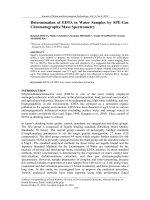
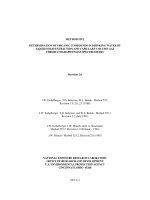
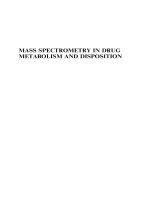
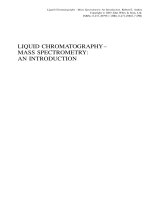
![niessen - liquid chromatography - mass spectrometry 3e [lcms] (crc, 2006)](https://media.store123doc.com/images/document/14/ne/ea/medium_eaq1401870789.jpg)
